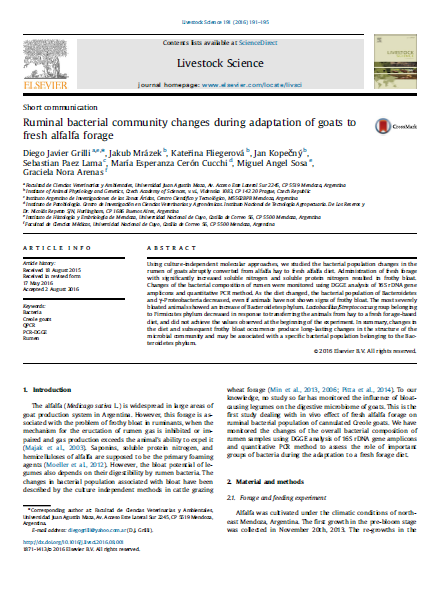Ruminal bacterial community changes during adaptation of goats to fresh alfalfa forage.
Date
2016-08-02Author
Grilli, Diego Javier
Mrázek, Jakub
Fliegerová, Kateřina
Kopečný, Jan
Paez Lama, Sebastian
Cerón Cucchi, María Esperanza
Sosa, Miguel Angel
Arenas, Graciela Nora
Metadata
Show full item recordAbstract
Using culture-independent molecular approaches, we studied the bacterial population changes in the rumen of goats abruptly converted from alfalfa hay to fresh alfalfa diet. Administration of fresh forage with significantly increased soluble nitrogen and soluble protein nitrogen resulted in frothy bloat. Changes of the bacterial composition of rumen were monitored using DGGE analysis of 16S rDNA gene amplicons and quantitative PCR method. As the diet changed, the bacterial population of Bacteroidetes and γ-Proteobacteria decreased, even if animals have not shown signs of frothy bloat. The most severely bloated animals showed an increase of Bacteroidetes phylum. Lactobacillus/Streptococcus group belonging to Firmicutes phylum decreased in response to transferring the animals from hay to a fresh forage-based diet, and did not achieve the values observed at the beginning of the experiment. In summary, changes in the diet and subsequent frothy bloat occurrence produce long-lasting changes in the structure of the microbial community and may be associated with a specific bacterial population belonging to the Bacteroidetes phylum. Fil: Grilli, Diego Javier. Facultad de Ciencias Veterinarias y Ambientales, Universidad Juan Agustín Maza, Av. Acceso Este Lateral Sur 2245, CP5519 Mendoza, Argentina. Instituto de Histología y Embriología de Mendoza, Universidad Nacional de Cuyo, Casilla de Correo 56, CP 5500 Mendoza, Argentina. Fil: Mrázek, Jakub. Institute of Animal Physiology and Genetics, Czech Academy of Sciences, v.v.i., Videnska 1083, CP 142 20 Prague, Czech Republic. Fil: Fliegerováb, Kateřina. Institute of Animal Physiology and Genetics, Czech Academy of Sciences, v.v.i., Videnska 1083, CP 142 20 Prague, Czech Republic. Fil: Kopečný, Jan. Institute of Animal Physiology and Genetics, Czech Academy of Sciences, v.v.i., Videnska 1083, CP 142 20 Prague, Czech Republic. Fil: Paez Lama, Sebastian. Instituto Argentino de Investigaciones de las Zonas Áridas, Centro Científico y Tecnológico, M5502BPB Mendoza, Argentina. Fil: Cerón Cucchi, María Esperanza. Instituto de Patobiología. Centro de Investigación en Ciencias Veterinarias y Agronómicas. Instituto Nacional de Tecnología Agropecuaria. De Los Reseros y Dr. Nicolás Repetto S/N, Hurlingham, CP 1686 Buenos Aires, Argentina. Fil: Sosa, Miguel Ángel. Instituto de Histología y Embriología de Mendoza, Universidad Nacional de Cuyo, Casilla de Correo 56, CP 5500 Mendoza, Argentina. Fil: Arenas, Graciela Nora. Facultad de Ciencias Médicas, Universidad Nacional de Cuyo, Casilla de Correo 56, CP 5500 Mendoza, Argentina.
URI
http://repositorio.umaza.edu.ar//handle/00261/1747https://www.sciencedirect.com/science/article/abs/pii/S187114131630172X#!











